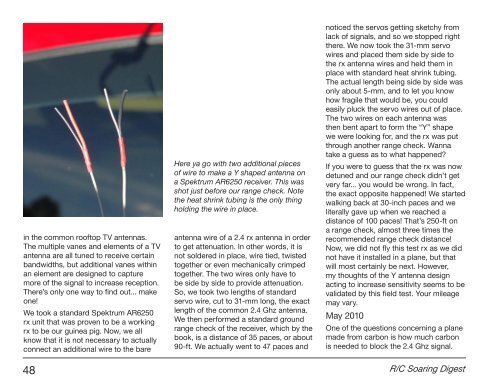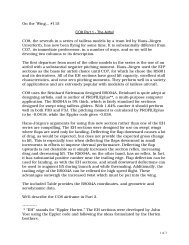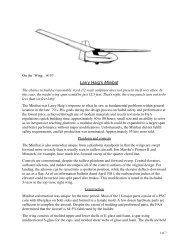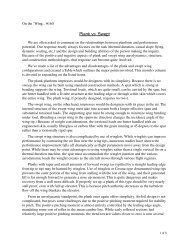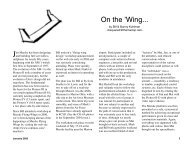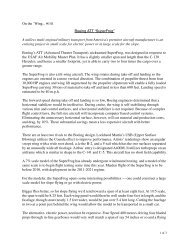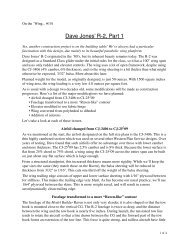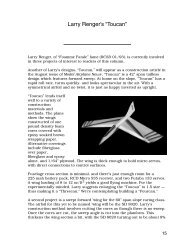Mar - Rcsoaring.com
Mar - Rcsoaring.com
Mar - Rcsoaring.com
You also want an ePaper? Increase the reach of your titles
YUMPU automatically turns print PDFs into web optimized ePapers that Google loves.
in the <strong>com</strong>mon rooftop TV antennas.<br />
The multiple vanes and elements of a TV<br />
antenna are all tuned to receive certain<br />
bandwidths, but additional vanes within<br />
an element are designed to capture<br />
more of the signal to increase reception.<br />
There’s only one way to find out... make<br />
one!<br />
We took a standard Spektrum AR6250<br />
rx unit that was proven to be a working<br />
rx to be our guinea pig. Now, we all<br />
know that it is not necessary to actually<br />
connect an additional wire to the bare<br />
Here ya go with two additional pieces<br />
of wire to make a Y shaped antenna on<br />
a Spektrum AR6250 receiver. This was<br />
shot just before our range check. Note<br />
the heat shrink tubing is the only thing<br />
holding the wire in place.<br />
antenna wire of a 2.4 rx antenna in order<br />
to get attenuation. In other words, it is<br />
not soldered in place, wire tied, twisted<br />
together or even mechanically crimped<br />
together. The two wires only have to<br />
be side by side to provide attenuation.<br />
So, we took two lengths of standard<br />
servo wire, cut to 31-mm long, the exact<br />
length of the <strong>com</strong>mon 2.4 Ghz antenna.<br />
We then performed a standard ground<br />
range check of the receiver, which by the<br />
book, is a distance of 35 paces, or about<br />
90-ft. We actually went to 47 paces and<br />
noticed the servos getting sketchy from<br />
lack of signals, and so we stopped right<br />
there. We now took the 31-mm servo<br />
wires and placed them side by side to<br />
the rx antenna wires and held them in<br />
place with standard heat shrink tubing.<br />
The actual length being side by side was<br />
only about 5-mm, and to let you know<br />
how fragile that would be, you could<br />
easily pluck the servo wires out of place.<br />
The two wires on each antenna was<br />
then bent apart to form the “Y” shape<br />
we were looking for, and the rx was put<br />
through another range check. Wanna<br />
take a guess as to what happened<br />
If you were to guess that the rx was now<br />
detuned and our range check didn’t get<br />
very far... you would be wrong. In fact,<br />
the exact opposite happened! We started<br />
walking back at 30-inch paces and we<br />
literally gave up when we reached a<br />
distance of 100 paces! That’s 250-ft on<br />
a range check, almost three times the<br />
re<strong>com</strong>mended range check distance!<br />
Now, we did not fly this test rx as we did<br />
not have it installed in a plane, but that<br />
will most certainly be next. However,<br />
my thoughts of the Y antenna design<br />
acting to increase sensitivity seems to be<br />
validated by this field test. Your mileage<br />
may vary.<br />
May 2010<br />
One of the questions concerning a plane<br />
made from carbon is how much carbon<br />
is needed to block the 2.4 Ghz signal.<br />
48 R/C Soaring Digest


